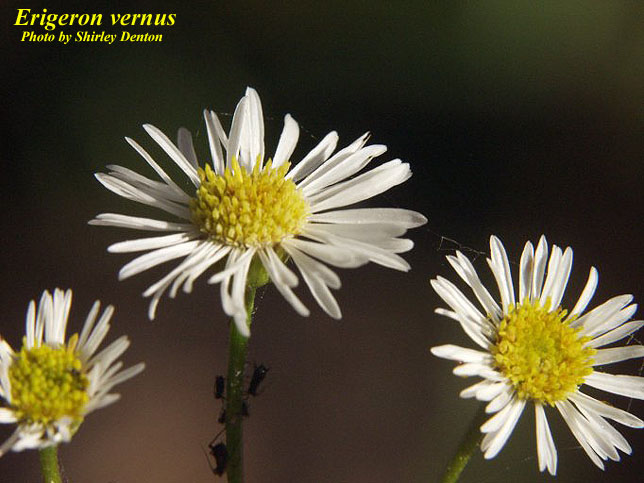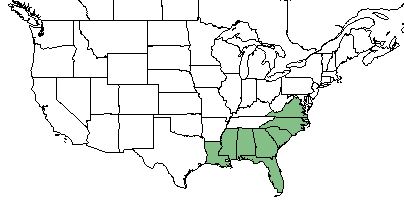Difference between revisions of "Erigeron vernus"
(→Conservation and Management) |
|||
| Line 49: | Line 49: | ||
==Conservation and Management== | ==Conservation and Management== | ||
| + | This species is imperiled in Virginia, and possibly extirpated in Washington D.C.<ref>[[http://explorer.natureserve.org]] NatureServe Explorer. Accessed: May 9, 2019</ref> | ||
==Cultivation and restoration== | ==Cultivation and restoration== | ||
Revision as of 16:26, 9 May 2019
Common name: early whitetop fleabane [1], whitetop fleabane [2]
| Erigeron vernus | |
|---|---|

| |
| Photo by the Atlas of Florida Plants Database | |
| Scientific classification | |
| Kingdom: | Plantae |
| Division: | Magnoliophyta - Flowering plants |
| Class: | Magnoliopsida - Dicots |
| Order: | Asterales |
| Family: | Asteraceae |
| Genus: | Erigeron |
| Species: | E. vernus |
| Binomial name | |
| Erigeron vernus L | |

| |
| Natural range of Erigeron vernus from USDA NRCS Plants Database. | |
Contents
Taxonomic Notes
Synonyms: none
Varieties: none
Description
E. vernus is a perennial forb/herb of the Asteraceae family native to North America. [1]
Distribution
E. vernus is found along the southeastern coast of the United States from Louisiana to Virginia. [1]
Ecology
Habitat
E. vernus proliferates in wet savannas, seepages, and interdunal swales. [2] Specimens have been collected from edge of pond, dry loamy sands, wet pine flatwoods, hardwood swamp, peaty ditch, cypress swamp, prairie, hillside bog, and disturbed areas such as next to a track field and roadside ditches. [3] It has been noted that E. vernus is abundant in areas with hog rooting. [4] It is listed by the USDA Natural Resources Conservation Service as an obligate wetland species that only can be found in wetland habitats.[1]
Phenology
Generally, E. vernus flowers from late March until June.[2] It has been observed flowering January through July and September. [5]
Fire ecology
E. vernus has been considered fire-stimulated. It largely flowers after a recent burn, particularly in pine savanna habitats. [4]
Use by animals
E. vernus has poor forage value.[6] This species supports conservation biological control through attracting predatory or parasitoid insects that in turn prey on pest insects.[7]
Conservation and Management
This species is imperiled in Virginia, and possibly extirpated in Washington D.C.[8]
Cultivation and restoration
Photo Gallery
References and notes
- ↑ 1.0 1.1 1.2 1.3 USDA Plant Database https://plants.usda.gov/core/profile?symbol=ERVE
- ↑ 2.0 2.1 2.2 Weakley, A. S. (2015). Flora of the Southern and Mid-Atlantic States. Chapel Hill, NC, University of North Carolina Herbarium.
- ↑ URL: http://herbarium.bio.fsu.edu. Last accessed: June 2018. Collectors: Ed Keppner, Lisa Keppner, Loran C. Anderson, Cecil Slaughter, R. Kral, Ann F. Johnson, R.K. Godfrey, Morris Adams, A.F. Clewell, E. Tyson, Paul L. Redfearn, Robert Norris, Bruce Hansen, JoAnn Hansen, D.W. Mather, Lloyd H. Shinners, Grady Reinert, N. Summerlin, M. Knott, J.P. Gillespie, W.D. Reese, E.M. Hodgson, C.Jackson, Gerould Wilhelm, Mabel Kral, George Cooley, Richard Eaton, James D. Ray, K. Craddock Burks, R. Komarek, J.M. Kane. States and counties: Florida (Bay, Wakulla, Putnam, Flagler, Nassau, Franklin, Liberty, Volusia, Washington, Walton, Hamilton, Jefferson, Okaloosa, Marion, Escambia, Osceola, Calhoun, Union, Jackson, Bradford, Charlotte, Martin, Citrus, Dixie, Jefferson) Georgia (Thomas)
- ↑ 4.0 4.1 Observation by Edwin Bridges comment on Jimi Cheak post, August 11, 2017, posted to Florida Flora and Ecosystematics Facebook Group. Cite error: Invalid
<ref>tag; name "FFE" defined multiple times with different content - ↑ Nelson, G. PanFlora: Plant data for the eastern United States with emphasis on the Southeastern Coastal Plains, Florida, and the Florida Panhandle. www.gilnelson.com/PanFlora/ Accessed: 21 MAY 2018
- ↑ Hilmon, J. B. (1964). "Plants of the Caloosa Experimental Range " U.S. Forest Service Research Paper SE-12
- ↑ [[1]] Lady Bird Johnson Wildflower Center. Accessed: May 9, 2019
- ↑ [[2]] NatureServe Explorer. Accessed: May 9, 2019